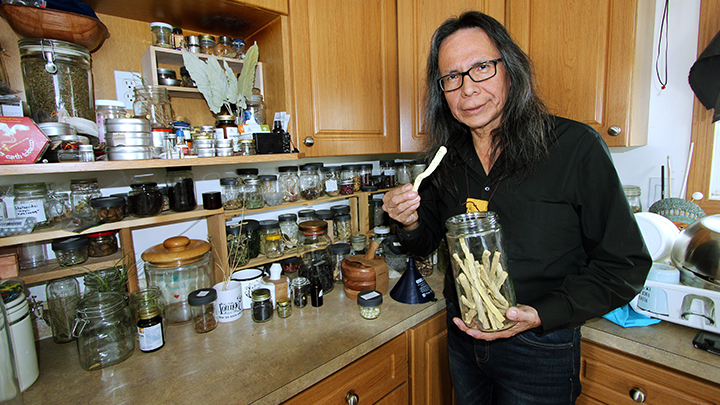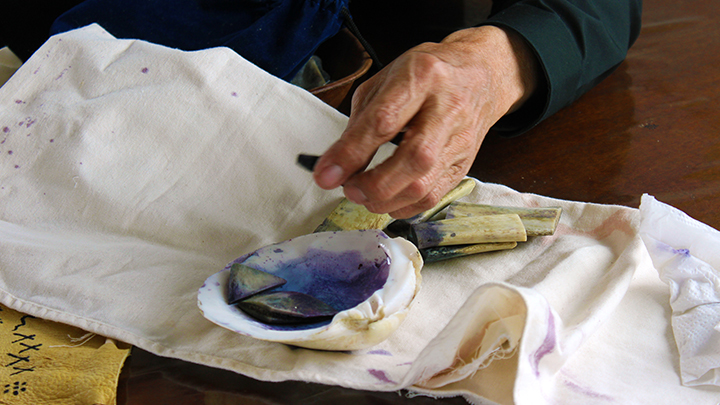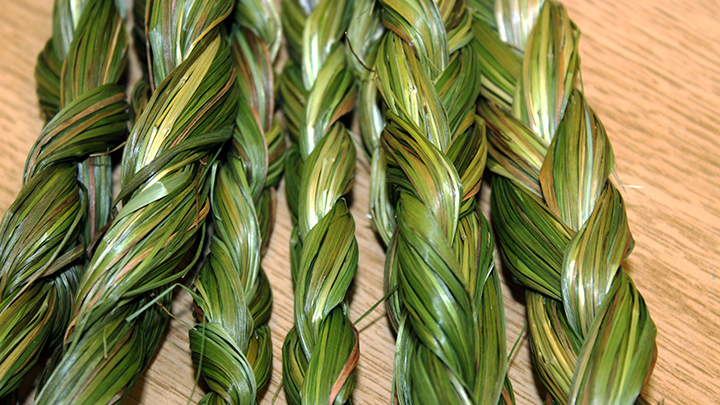
May 30, 2023

William Singer, in the kitchen of his home, takes a dried licorice root from a jar to explain it’s medicinal qualities. Beside him is an assortment of dried leaves, roots and berries he uses for food, tea, medicine and in ceremonies. Photo by Sherri Gallant.

William Singer’s focus is to live by traditional ways in all things. As an artist, he sometimes employs ancient techniques, as shown here. His palette is a clamshell. His brushes are a cut bovine rib bone. His paint is made with berries and flowers. Photo by Sherri Gallant.

These braided strands of sweetgrass, picked on the Kainai Nation, will be used for ceremonial purposes. Photo by Sherri Gallant.
Story & photos by Sherri Gallant
Health centres in the South Zone are rising to a challenge to establish Healing Gardens on their grounds — welcoming places where planter boxes will soon be resplendent with sage, sweetgrass, saskatoon berries and wild mint.
The challenge has been set forth by Indigenous Health to celebrate Indigenous Peoples Awareness Month this June, preparing planter boxes to receive seedlings and plugs of the four Traditional Medicinal plants. Their arrival signals the start of a multi-year challenge to grow and enhance the healing garden space at each site, with the first year being focused on learning about them while watching them grow and mature, then harvesting for use.
A healing garden at a healthcare site acknowledges the powerful connection Indigenous people have to the land. It helps create a welcoming facility where Blackfoot culture is honoured and included, narrowing the gaps in health outcomes for Indigenous patients. This form of reconciliACTION will answer some of the Calls to Action from the Truth and Reconciliation Commission of Canada regarding health (Calls to Action 18-22).
While the project is focused on Indigenous Health, the peaceful outdoor spaces will provide a source of spirit renewal for all patients and families. The targeted planting date is prior to June 21 — National Indigenous Peoples Day.
Organizers have been relying on the wisdom of William Singer (Api'soomaahka, or Running Coyote), the Blackfoot creator of the Naapi’s Garden and Katoyiss Seed Bank projects, who’s a renowned authority on traditional plants. Singer has informed the work, and is providing support and education, about the health benefits and traditional use of plants indigenous to the land and to Indigenous wellness.
“It’s important to have that connection to plant life,” says Singer, “especially plants that grow on the land. They have a lot of different uses and if it’s for a garden box at the hospital — one of their many benefits is their unique fragrance. When we smell these different smells our body reacts to them in different ways.
“For instance with sweetgrass, when you smell it, immediately your body becomes relaxed. Same with mint, and that’s something that not only smells good — it can clear your sinuses, and it helps your stomach as well. Once these plants that grow on the land are growing on hospital grounds, patients or the staff can use them to create their own medicines. Or have an Elder come in and do some teachings on sweetgrass protocol — how to braid it; cutting it — (e.g., we don’t pull it out by the roots, we cut it).”
Some sites may already have an outdoor space where planters can be added, and others may need to begin with the planters and work on developing the space over time. As they prepare their spaces, site leaders are being encouraged to work with staff, patients, volunteers, Indigenous liaisons and physicians to identify the space to be used, one that’s comfortable and accessible to patients and families.
Singer teaches people about how sweetgrass is used in smudge, as an energy food and to treat cough, cold and fever. He explains how mint can be made into tea for comfort, or to treat upset stomach and sore throat. He talks about how the silver-green leaves of sage can be chewed for sore throat, and how the holy plant is used in ceremonies. And saskatoons referred to as the ‘real berry’ by the Blackfoot people — are not only used as food and medicine, but also for tools, arrow shafts and pipe stems.
“With healthcare,” Singer adds, “we’re looking at two different systems — Western and Traditional — and they’re really different. Traditional medicines and how they work may seem pagan to a lot of doctors, but we’re still here. The plants have really helped us survive. (It’s important to understand that) none of these plants will cause you harm. What Alberta Health Services (AHS) is doing with introducing plants — it’s a start. Aside from other ways of connecting, plants are the most important thing. Connect with the plants. Things will start unfolding.”
Singer explains how sage is used to smudge. “When you smudge with it alone, it helps with your mental awareness and mental health. When you combine it with sweetgrass, you create an even stronger medicine. Those basically are plants that really help your mind. But also sage on its own is a really good medicine if you have a sore throat. It’s good to cook with, you can make a tea, if you want to cover up your scent, you rub it all over your body (as Indigenous hunters did), you can eat it, you can even put it in your shoes for protection.”
Saskatoon berry is a good source of calcium and vitamin C, aids digestion and is a good source for dyes. “I’m an artist and I got interested in creating our own dyes. Some of them were given to me by my grandmothers, who would tell me stories. The dyes are not harmful. And when you do art with plant dyes, it smells like berries. It smells like what you’re working with. We’re carrying on these traditions.”
Saskatoons are also used to make a pemmican and tea. “They’re really important plants,” he added. “And all these plants we’re talking about are important in our societies and our ceremonies. We can’t do a lot of our things without them.”
When the time comes to harvest the carefully nurtured plants, Singer lights up as he speaks of the rewards.
“When you have a yield and see all the stuff you harvested — it’s like winning money or having something really good happen. It’s hard to explain. You did that. And, when you grow these plants, you’re helping nature. The plants we’re talking about are plants that are in decline.
“This is an opportunity to share the knowledge and for the larger community to get a sense of our history. In the Blackfoot world view, we want to teach and share our knowledge within our community, but now that we have a larger community off the reserve, one of the things we like to teach is our way of life. And our way of life is really connected to the land. It’s that connection that we want to emphasize.”